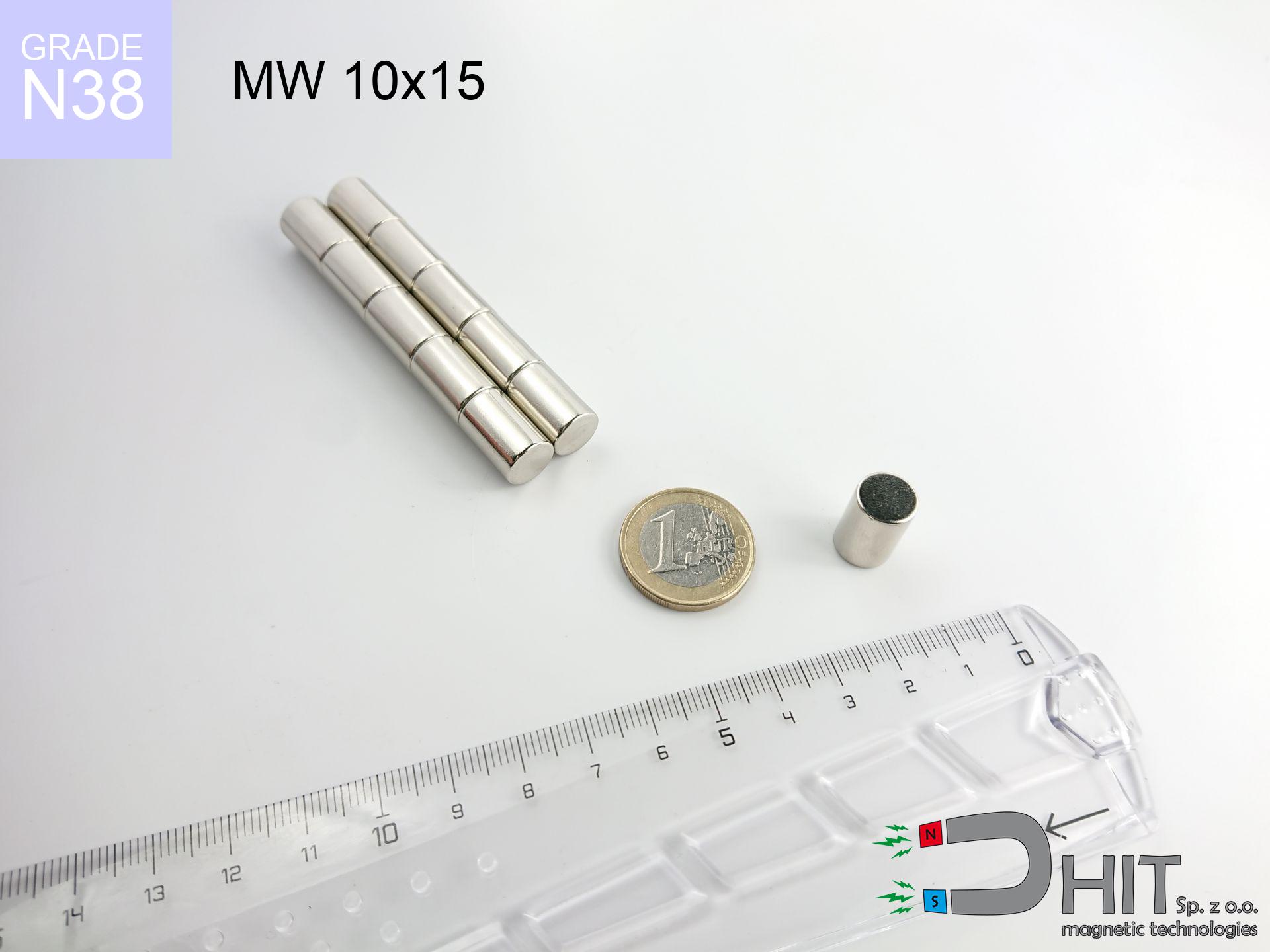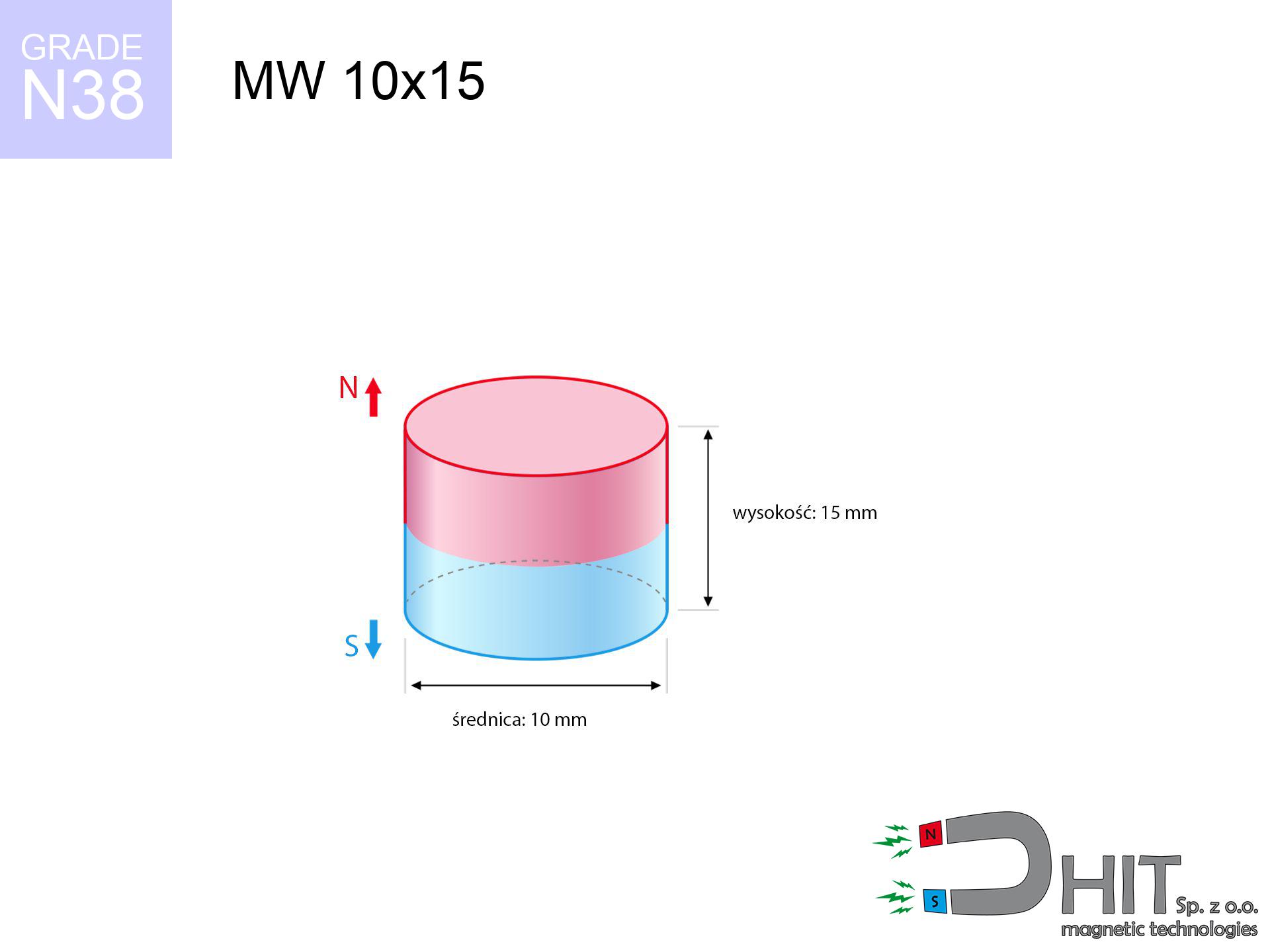MW 10x15 / N38 - neodymium magnet
cylindrical magnet
catalog number 010005
GTIN: 5906301810049
diameter Ø
10
mm [±0,1 mm]
height
15
mm [±0,1 mm]
magnetizing direction
↑ axial
capacity ~
8.29 kg / 81.30 N
magnetic induction ~
587.44 mT / 5,874 Gs
max. temperature
≤ 80
°C
catalog number 010005
GTIN: 5906301810049
diameter Ø
10 mm [±0,1 mm]
height
15 mm [±0,1 mm]
magnetizing direction
↑ axial
capacity ~
8.29 kg / 81.30 N
magnetic induction ~
587.44 mT / 5,874 Gs
max. temperature
≤ 80 °C
5.17 ZŁ gross price (including VAT) / pcs +
4.20 ZŁ net price + 23% VAT / pcs
bulk discounts:
need more quantity?Do you have a problem in choosing?
Call us tel: +48 888 99 98 98 or write through contact form on our website. You can check the mass and the appearance of neodymium magnet in our magnetic mass calculator force calculator
Orders placed by 2:00 PM will be shipped on the same business day.
Specification: cylindrical magnet 10x15 / N38 ↑ axial
Magnetic properties of the material N38
Physical properties of sintered neodymium magnets Nd2Fe14B
Moreover, even though neodymium is part of the strongest magnets, they are susceptible to corrosion in humid environments. For this reason, they are coated with a coating of nickel to increase their durability. Interestingly that NdFeB neodymium magnets are about 13% lighter than SmCo magnets and, despite their power, easily break, which requires special caution during their handling. Therefore, any mechanical processing should be done before they are magnetized.
In terms of safety, there are many recommendations regarding the use of these magnets. It is advisable to avoid their use in acidic, basic, organic environments or where solvents are present, as well as in water or oil. Furthermore, they can distort data on magnetic cards and hard drives, although data deletion using a neodymium magnet is not guaranteed.
In terms of properties in different environments, neodymium magnets are sensitive to corrosion, especially in conditions of high humidity. Therefore, they are often covered with thin coatings, such as gold, to shield them from environmental factors and prolong their durability. Temperatures exceeding 130°C can result in a loss of their magnetic strength, although there are particular types of neodymium magnets that can withstand temperatures up to 230°C.
As for dangers, it is important to avoid using neodymium magnets in acidic conditions, basic conditions, organic or solvent environments, unless they are adequately insulated. Additionally, their use is not recommended in water, oil, or in an atmosphere containing hydrogen, as they may lose their magnetic strength.
Find suggested articles
Advantages and disadvantages of neodymium magnets NdFeB.
In addition to immense power, neodymium magnets have the following advantages:
- They do not lose strength over time - after approximately 10 years, their power decreases by only ~1% (theoretically),
- They are extremely resistant to demagnetization by external magnetic sources,
- Thanks to the shiny finish and nickel, gold, or silver coating, they have an aesthetic appearance,
- They exhibit extremely high magnetic induction on the surface of the magnet,
- By using an appropriate combination of materials, they can achieve high thermal resistance, allowing them to operate at temperatures up to 230°C and above...
- The ability for precise shaping or customization to specific needs – neodymium magnets can be produced in many variants of shapes and sizes, which amplifies their universality in usage.
- Significant importance in advanced technologically fields – are utilized in computer drives, electric motors, medical apparatus and very modern machines.
Disadvantages of neodymium magnets:
- They can break as they are extremely fragile when subjected to a powerful impact. If the magnets are exposed to impacts, it is suggested using magnets in a protective case. The steel housing in the form of a holder protects the magnet from impacts and simultaneously increases its overall strength,
- High temperatures can reduce the power of neodymium magnets. Typically, after heating above 80°C, most of them experience a permanent loss in strength (although it is dependent on the form and size). To prevent this, we offer special magnets marked with the symbol [AH], which are highly resistant to high temperatures. They can operate even at temperatures up to 230°C, making them an ideal solution for applications requiring high-temperature operation,
- They rust in a humid environment - during outdoor use, we recommend using waterproof magnets, such as those made of rubber or plastic,
- The use of a cover or a magnetic holder is recommended due to the limited possibilities of manufacturing threads or complex shapes in the magnet
- Potential hazard arising from small pieces of magnets pose a threat, if swallowed, which is crucial in the context of child safety. Additionally, miniscule components of these products can complicate diagnosis after entering the body.
Be Cautious with Neodymium Magnets
Neodymium magnetic are delicate and can easily break as well as get damaged.
Neodymium magnets are extremely fragile, and by joining them in an uncontrolled manner, they will break. Neodymium magnets are made of metal and coated with a shiny nickel surface, but they are not as hard as steel. At the moment of collision between the magnets, sharp metal fragments can be dispersed in different directions.
Magnets are not toys, youngest should not play with them.
Remember that neodymium magnets are not toys. Do not allow children to play with them. They can be a significant choking hazard. If multiple magnets are swallowed, they can attract to each other through the intestinal walls, causing significant injuries, and even death.
Neodymium magnets are among the most powerful magnets on Earth. The surprising force they generate between each other can shock you.
Read the information on our website on how to properly utilize neodymium magnets and avoid significant harm to your body and unintentional damage to the magnets.
Neodymium magnets are not recommended for people with pacemakers.
Neodymium magnets produce strong magnetic fields that can interfere with the operation of a heart pacemaker. However, if the magnetic field does not affect the device, it can damage its components or deactivate the device when it is in a magnetic field.
Magnets will attract to each other, so remember not to allow them to pinch together without control or place your fingers in their path.
Neodymium magnets bounce and clash mutually within a radius of several to around 10 cm from each other.
The magnet is coated with nickel. Therefore, exercise caution if you have an allergy.
Studies clearly indicate a small percentage of people who suffer from metal allergies such as nickel. An allergic reaction often manifests as skin redness and rash. If you have a nickel allergy, you can try wearing gloves or simply avoid direct contact with nickel-plated neodymium magnets.
Dust and powder from neodymium magnets are flammable.
Do not attempt to drill into neodymium magnets. Mechanical processing is also not recommended. Once crushed into fine powder or dust, this material becomes highly flammable.
Do not place neodymium magnets near a computer HDD, TV, and wallet.
Neodymium magnets produce intense magnetic fields that can damage magnetic media such as floppy disks, video tapes, HDDs, credit cards, magnetic ID cards, cassette tapes, or other devices. They can also destroy devices like video players, televisions, CRT computer monitors. Do not forget to keep neodymium magnets away from these electronic devices.
Keep neodymium magnets as far away as possible from GPS and smartphones.
Neodymium magnets are a source of intense magnetic fields that cause interference with magnetometers and compasses used in navigation, as well as internal compasses of smartphones and GPS devices.
Neodymium magnets can demagnetize at high temperatures.
Although magnets have demonstrated their effectiveness up to 80°C or 175°F, the temperature can vary depending on the type, shape, and intended use of the specific magnet.
Please see the article - What danger lies in neodymium magnets? You will learn how to handle them properly.



![magnetic holder rubber internal thread 29x8 [M4] GW / N38 magnetic holder rubber internal thread 29x8 [M4] GW / N38](https://cdn3.dhit.pl/graphics/products/umg-29x8-m4-gw-duf.jpg)
![magnetic separator 25x325 [2xM8] / N42 magnetic separator 25x325 [2xM8] / N42](https://cdn3.dhit.pl/graphics/products/sm-25x325-2xm8-man.jpg)

![rubber magnetic holder external thread 66x8.5 [M8] GZ / N38 rubber magnetic holder external thread 66x8.5 [M8] GZ / N38](https://cdn3.dhit.pl/graphics/products/umggz-66x8.5-m6-gz-gas.jpg)

